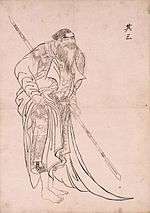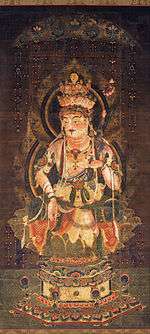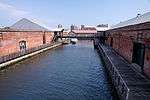List of Cultural Properties of Japan - paintings (Hokkaidō)
This list is of the Cultural Properties of Japan designated in the category of paintings (絵画 kaiga) for the Circuit of Hokkaidō.[1]
National Cultural Properties
As of 1 September 2016, zero properties have been designated as being of national significance.[2][3]
Prefectural Cultural Properties
As of 21 September 2016, four properties have been designated at a prefectural level.[4][5][6]
| Property | Date | Municipality | Ownership | Comments | Image | Dimensions | Coordinates | Ref. |
|---|---|---|---|---|---|---|---|---|
| Nirvana painting, by Kakizaki Hakyō 釈迦涅槃図蠣崎波響筆 Shaka nehan-zu Kakizaki Hakyō-hitsu | 1811 | Hakodate | Kōryū-ji (高龍寺) | pair of scrolls[7][8] | .jpg) | 2.99 metres (9.8 ft) by 1.405 metres (4.61 ft) | 41°46′07″N 140°41′58″E / 41.768703°N 140.699565°E | |
| Ishū Retsuzō sketchbook 夷酋列像粉本 Ishū Retsuzō funpon | 1790 | Hakodate | Hakodate City Central Library (函館市中央図書館) | portraits by Kakizaki Hakyō of twelve Ainu chiefs who had cooperated with the Matsumae domain during the Menashi-Kunashir Rebellion[8][9] |  | 45 centimetres (18 in) by 42.5 centimetres (16.7 in) | 41°47′54″N 140°45′12″E / 41.798264°N 140.753424°E | |
| Byōbu of Matsumae 松前屏風 Matsumae byōbu | 1754-64 | Matsumae | Matsumae Town Historical Museum (松前町郷土資料館) | 6 panels, by Kodama Teiryō (小玉貞良)[10] |  | 3.648 metres (11.97 ft) by 1.57 metres (5.2 ft) | 41°26′08″N 140°06′43″E / 41.435632°N 140.111947°E | |
| Kamui nomi, ema 絵馬カムイノミの図 ema kamui-nomi no zu | 1899 | Toyokoro | Ōtsuinaka Jinja (大津稲荷神社) | Kamui nomi is a ritual prayer to the kami for bounty; the ema, by Kawanabe Kyōsai, shows the Tokachi fishing grounds were harvested by the Ainu[11] | .jpg) | 42°41′12″N 143°38′53″E / 42.686639°N 143.647935°E | ||
Municipal Cultural Properties
As of 1 May 2016, forty-three properties have been designated at a municipal level.[12][13]
| Property | Date | Municipality | Ownership | Comments | Image | Dimensions | Coordinates | Ref. |
|---|---|---|---|---|---|---|---|---|
| Ceiling paintings in the Daibutsu-ji Hondō 大仏寺本堂の天井画 Daibutsuji hondō no tenjō-ga | Kutchan | Daibutsu-ji (大仏寺) | 42°54′01″N 140°44′13″E / 42.900230°N 140.737074°E | for all refs see | ||||
| Bird's-eye view of the prosperous Yunai fishing grounds 湯内漁場盛業鳥瞰図 Yunai ryōba seigyō chōkanzu | Meiji period | Yoichi | Yoichi Fisheries Museum (よいち水産博物館) | 43°11′48″N 140°47′13″E / 43.196668°N 140.786851°E | ||||
| Bird's-eye view of Yoichi during the Ansei era 安政年間のヨイチ鳥瞰図 Ansei-nenkan no Yoichi chōkanzu | c.1857 | Yoichi | private | 43°11′32″N 140°47′26″E / 43.192132°N 140.790476°E | ||||
| Hayashi Shihei map 林子平東邦地図 Hayashi Shihei tōhō chizu | Yoichi | 43°11′48″N 140°47′12″E / 43.196662°N 140.786746°E | ||||||
| Ainu Painting (Warrior's Banner Sketching) アイヌ絵(武者のぼり下絵) Ainu-e (musha-nobori shita-e) | Bunsei era | Yoichi | Old Shimoyoichi Unjōya (旧下ヨイチ運上家) | by Hayasaka Bunrei (早坂文嶺);[14] parallels have been drawn by scholars between the image of the warrior and that of Minamoto no Tametomo;[15] the Ainu elder plays a tonkori | .jpg) | 3 metres (9.8 ft) | 43°11′52″N 140°47′16″E / 43.197793°N 140.787852°E | |
| Bodhidharma, by the priest Tōkai 東開和尚筆達磨絵 Tōkai-oshō hitsu Daruma-e | Meiji period | Yoichi | Eizen-ji (永全寺) | 43°12′04″N 140°46′01″E / 43.201191°N 140.767049°E | ||||
| Nichizō Bosatsu, inscribed hanging scroll 日像菩薩本尊銘の掛軸 Hikata bosatsu honzon mei no kakejiku | 1334 | Yoichi | Hokke-ji (法華寺) | 43°11′52″N 140°46′07″E / 43.197769°N 140.768512°E | ||||
| Sketches of the plants and trees of Ezo, by Kobayashi Gennosuke 小林源之助著 蝦夷地草木写生図 Kobayashi Gennosuke-cho Ezo-chi kusaki shasei zu | 1792 | Hakodate | Hakodate City Central Library (函館市中央図書館) | two volumes | 28.5 centimetres (11.2 in) by 18.5 centimetres (7.3 in) | 41°47′54″N 140°45′12″E / 41.798264°N 140.753424°E | ||
| Customs of Ezo, by Kodama Teiryō 小玉貞良筆 蝦夷国風図絵 Kodama Teiryō hitsu Ezo-koku fūzu-e | C18 | Hakodate | Hakodate City Central Library (函館市中央図書館) | one scroll; depicts Ainu customs such as fishing and harvesting seaweed | 28 centimetres (11 in) by 9.78 metres (32.1 ft) | 41°47′54″N 140°45′12″E / 41.798264°N 140.753424°E | ||
| Ainu customs of the twelve months, byōbu アイヌ風俗12カ月屏風 Ainu fūzoku 12-kagetsu byōbu | C19 | Hakodate | Hakodate City Museum (市立函館博物館) | pair of six-fold screens; by Hirosawa Byōzan (平沢屏山); the first six panels are a later copy | 139 centimetres (4.56 ft) by 51.5 centimetres (20.3 in) to 52.5 centimetres (20.7 in) | 41°45′22″N 140°42′52″E / 41.756014°N 140.714497°E | ||
| Eight views of Yanagawa 梁川八景 Yanagawa hakkei | c.1807 | Hakodate | Hakodate City Central Library (函館市中央図書館) | by Kakizaki Hakyō | 21.6 centimetres (8.5 in) by 53.5 centimetres (21.1 in) | 41°47′54″N 140°45′12″E / 41.798264°N 140.753424°E | ||
| Chinese Beauty 唐美人 Kara-bijin | c.1815 | Hakodate | Hakodate City Museum (市立函館博物館) | by Kakizaki Hakyō | .jpg) | 108 centimetres (43 in) by 44 centimetres (17 in) | 41°45′22″N 140°42′52″E / 41.756014°N 140.714497°E | |
See also
References
- ↑ "Cultural Properties for Future Generations". Agency for Cultural Affairs. Retrieved 2 October 2016.
- ↑ 国宝・重要文化財 [Number of National Treasures and Important Cultural Properties by Prefecture] (in Japanese). Agency for Cultural Affairs. 1 September 2016. Retrieved 2 October 2016.
- ↑ "Database of National Cultural Properties: 国宝・重要文化財(美術品)(絵画 北海道)" (in Japanese). Agency for Cultural Affairs. Retrieved 2 October 2016.
- ↑ 北海道指定の文化財一覧 [List of Prefectural Cultural Properties] (in Japanese). Hokkaidō Government Board of Education. 21 September 2016. Retrieved 2 October 2016.
- ↑ 都道府県別指定等文化財件数(都道府県分) [Number of Prefectural Cultural Properties by Prefecture] (in Japanese). Agency for Cultural Affairs. 1 May 2016. Retrieved 2 October 2016.
- ↑ 北海道の指定文化財件数一覧 [Number of Cultural Properties of Hokkaido] (in Japanese). Hokkaido Government Board of Education. 17 August 2016. Retrieved 2 October 2016.
- ↑ 釈迦涅槃図蠣崎波響筆 [Nirvana painting, by Kakizaki Hakyō] (in Japanese). Agency for Cultural Affairs. Retrieved 29 September 2013.
- 1 2 函館市の文化財一覧 [List of Cultural Properties of Hakodate] (in Japanese). Hakodate City. 31 August 2016. Retrieved 2 October 2016.
- ↑ 夷酋列像粉本 [Ishū Retsuzō sketchbook] (in Japanese). Agency for Cultural Affairs. Retrieved 29 September 2013.
- ↑ 松前屏風 [Byōbu of Matsumae] (in Japanese). Agency for Cultural Affairs. Retrieved 29 September 2013.
- ↑ 絵馬カムイノミの図 [Kamui nomi, ema] (in Japanese). Agency for Cultural Affairs. Retrieved 29 September 2013.
- ↑ 市町村指定文化財一覧 [List of Municipal Cultural Properties] (in Japanese). Hokkaidō Government Board of Education. 1 May 2016. Retrieved 2 October 2016.
- ↑ 都道府県別指定等文化財件数(市町村分) [Number of Municipal Cultural Properties by Prefecture] (in Japanese). Agency for Cultural Affairs. 1 May 2016. Retrieved 2 October 2016.
- ↑ アイヌ民族を描いた早坂文嶺(松前) [Hayasaka Bunrei, Painter of the Ainu People (Matsumae)]. Asahi Shimbun (in Japanese). 7 September 2016. Retrieved 2 October 2016.
- ↑ Yamagiwa Akiko (2013). 余市町教育委員会所蔵の《アイヌ絵(武者のぼり下絵)》について:「島の為朝」図との関係 [Ainu Painting (Mushanobori Sketchings) from the Collection of Yoichi City: Its Connection with the Image of "Shima no Tametomo"]. Bulletin of the Historical Museum of Hokkaido (in Japanese). Historical Museum of Hokkaido (41): 247–56. Retrieved 2 October 2016.
External links
- (Japanese) Cultural Properties in Hokkaido
This article is issued from Wikipedia - version of the 10/27/2016. The text is available under the Creative Commons Attribution/Share Alike but additional terms may apply for the media files.


